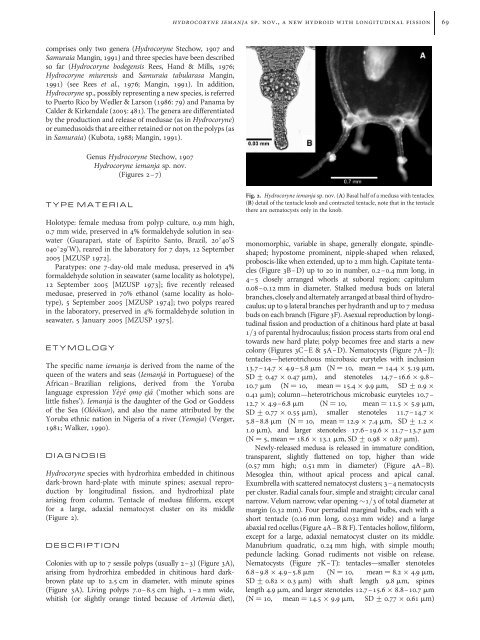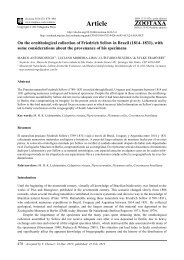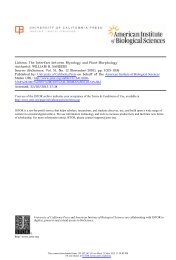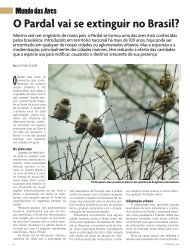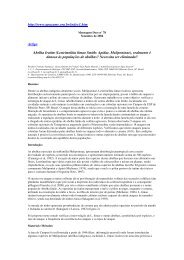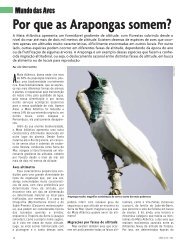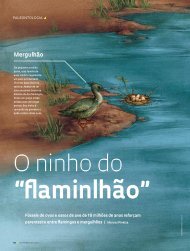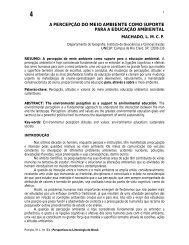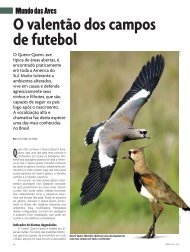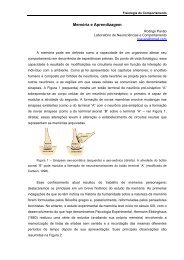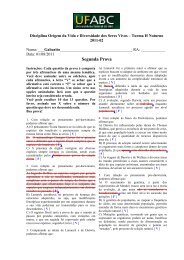Hydrocoryne iemanja (Cnidaria) - Instituto de Biociências - USP
Hydrocoryne iemanja (Cnidaria) - Instituto de Biociências - USP
Hydrocoryne iemanja (Cnidaria) - Instituto de Biociências - USP
Create successful ePaper yourself
Turn your PDF publications into a flip-book with our unique Google optimized e-Paper software.
hydrocoryne <strong>iemanja</strong> sp. nov., a new hydroid with longitudinal fission 69<br />
comprises only two genera (<strong>Hydrocoryne</strong> Stechow, 1907 and<br />
Samuraia Mangin, 1991) and three species have been <strong>de</strong>scribed<br />
so far (<strong>Hydrocoryne</strong> bo<strong>de</strong>gensis Rees, Hand & Mills, 1976;<br />
<strong>Hydrocoryne</strong> miurensis and Samuraia tabularasa Mangin,<br />
1991) (see Rees et al., 1976; Mangin, 1991). In addition,<br />
<strong>Hydrocoryne</strong> sp., possibly representing a new species, is referred<br />
to Puerto Rico by Wedler & Larson (1986: 79) and Panama by<br />
Cal<strong>de</strong>r & Kirkendale (2005: 481). The genera are differentiated<br />
by the production and release of medusae (as in <strong>Hydrocoryne</strong>)<br />
or eumedusoids that are either retained or not on the polyps (as<br />
in Samuraia) (Kubota, 1988; Mangin, 1991).<br />
Genus <strong>Hydrocoryne</strong> Stechow, 1907<br />
<strong>Hydrocoryne</strong> <strong>iemanja</strong> sp. nov.<br />
(Figures 2–7)<br />
TYPE MATERIAL<br />
Holotype: female medusa from polyp culture, 0.9 mm high,<br />
0.7 mm wi<strong>de</strong>, preserved in 4% formal<strong>de</strong>hy<strong>de</strong> solution in seawater<br />
(Guarapari, state of Espírito Santo, Brazil, 20840 0 S<br />
040829 0 W), reared in the laboratory for 7 days, 12 September<br />
2005 [MZ<strong>USP</strong> 1972].<br />
Paratypes: one 7-day-old male medusa, preserved in 4%<br />
formal<strong>de</strong>hy<strong>de</strong> solution in seawater (same locality as holotype),<br />
12 September 2005 [MZ<strong>USP</strong> 1973]; five recently released<br />
medusae, preserved in 70% ethanol (same locality as holotype),<br />
5 September 2005 [MZ<strong>USP</strong> 1974]; two polyps reared<br />
in the laboratory, preserved in 4% formal<strong>de</strong>hy<strong>de</strong> solution in<br />
seawater, 5 January 2005 [MZ<strong>USP</strong> 1975].<br />
ETYMOLOGY<br />
The specific name <strong>iemanja</strong> is <strong>de</strong>rived from the name of the<br />
queen of the waters and seas (Iemanjá in Portuguese) of the<br />
African–Brazilian religions, <strong>de</strong>rived from the Yoruba<br />
language expression Yèyé ȯmȯ ėjá (‘mother which sons are<br />
little fishes’). Iemanjá is the daughter of the God or God<strong>de</strong>ss<br />
of the Sea (Olóòkun), and also the name attributed by the<br />
Yoruba ethnic nation in Nigeria of a river (Yemȯja) (Verger,<br />
1981; Walker, 1990).<br />
DIAGNOSIS<br />
<strong>Hydrocoryne</strong> species with hydrorhiza embed<strong>de</strong>d in chitinous<br />
dark-brown hard-plate with minute spines; asexual reproduction<br />
by longitudinal fission, and hydrorhizal plate<br />
arising from column. Tentacle of medusa filiform, except<br />
for a large, adaxial nematocyst cluster on its middle<br />
(Figure 2).<br />
DESCRIPTION<br />
Colonies with up to 7 sessile polyps (usually 2–3) (Figure 3A),<br />
arising from hydrorhiza embed<strong>de</strong>d in chitinous hard darkbrown<br />
plate up to 2.5 cm in diameter, with minute spines<br />
(Figure 3A). Living polyps 7.0–8.5 cm high, 1–2 mm wi<strong>de</strong>,<br />
whitish (or slightly orange tinted because of Artemia diet),<br />
Fig. 2. <strong>Hydrocoryne</strong> <strong>iemanja</strong> sp. nov. (A) Basal half of a medusa with tentacles;<br />
(B) <strong>de</strong>tail of the tentacle knob and contracted tentacle, note that in the tentacle<br />
there are nematocysts only in the knob.<br />
monomorphic, variable in shape, generally elongate, spindleshaped;<br />
hypostome prominent, nipple-shaped when relaxed,<br />
proboscis-like when exten<strong>de</strong>d, up to 2 mm high. Capitate tentacles<br />
(Figure 3B–D) up to 20 in number, 0.2–0.4 mm long, in<br />
4–5 closely arranged whorls at suboral region; capitulum<br />
0.08–0.12 mm in diameter. Stalked medusa buds on lateral<br />
branches, closely and alternately arranged at basal third of hydrocaulus;<br />
up to 9 lateral branches per hydranth and up to 7 medusa<br />
buds on each branch (Figure 3F). Asexual reproduction by longitudinal<br />
fission and production of a chitinous hard plate at basal<br />
1/3 of parental hydrocaulus; fission process starts from oral end<br />
towards new hard plate; polyp becomes free and starts a new<br />
colony (Figures 3C–E & 5A–D). Nematocysts (Figure 7A–J):<br />
tentacles—heterotrichous microbasic euryteles with inclusion<br />
13.7–14.7 4.9–5.8 mm (N¼ 10, mean ¼ 14.4 5.19 mm,<br />
SD + 0.47 0.47 mm), and stenoteles 14.7–16.6 9.8–<br />
10.7 mm (N¼ 10, mean ¼ 15.4 9.9 mm, SD + 0.9 <br />
0.41 mm); column—heterotrichous microbasic euryteles 10.7–<br />
12.7 4.9–6.8 mm (N¼ 10, mean ¼ 11.5 5.9 mm,<br />
SD + 0.77 0.55 mm), smaller stenoteles 11.7–14.7 <br />
5.8–8.8 mm (N¼ 10, mean ¼ 12.9 7.4 mm, SD + 1.2 <br />
1.0 mm), and larger stenoteles 17.6–19.6 11.7–13.7 mm<br />
(N ¼ 5, mean ¼ 18.6 13.1 mm, SD + 0.98 0.87 mm).<br />
Newly-released medusa is released in immature condition,<br />
transparent, slightly flattened on top, higher than wi<strong>de</strong><br />
(0.57 mm high; 0.51 mm in diameter) (Figure 4A–B).<br />
Mesoglea thin, without apical process and apical canal.<br />
Exumbrella with scattered nematocyst clusters; 3–4 nematocysts<br />
per cluster. Radial canals four, simple and straight; circular canal<br />
narrow. Velum narrow; velar opening 1/3 of total diameter at<br />
margin (0.32 mm). Four perradial marginal bulbs, each with a<br />
short tentacle (0.16 mm long, 0.032 mm wi<strong>de</strong>) and a large<br />
abaxial red ocellus (Figure 4A–B & F). Tentacles hollow, filiform,<br />
except for a large, adaxial nematocyst cluster on its middle.<br />
Manubrium quadratic, 0.24 mm high, with simple mouth;<br />
peduncle lacking. Gonad rudiments not visible on release.<br />
Nematocysts (Figure 7K–T): tentacles—smaller stenoteles<br />
6.8–9.8 4.9–5.8 mm (N¼ 10, mean ¼ 8.2 4.9 mm,<br />
SD + 0.82 0.3 mm) with shaft length 9.8 mm, spines<br />
length 4.9 mm, and larger stenoteles 12.7–15.6 8.8–10.7 mm<br />
(N ¼ 10, mean ¼ 14.5 9.9 mm, SD + 0.77 0.61 mm)


